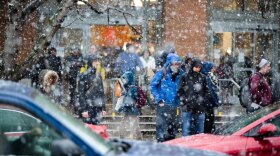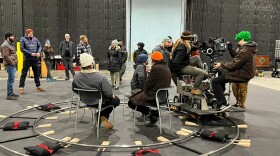Saiyare Refaei’s art and activism does not prioritize the prestige of spaces like galleries or museums, but rather the value of community. The Tacoma artist’s work lives at the intersection of the issues and the communities affected by them.
“I feel more like this conduit or bridge,” Refaei says.
The first-generation, non-binary Chinese/Iranian American is a mural artist, printmaker and organizer whose work spans many communities, too: from McMinnville, Oregon, to Parkland, from Oaxaca to Tacoma to West Papua.
Refaei grew up in McMinnville, home to Linfield College, where their parents met and their father works at the library. Refaei remembers spending their childhood in front of an easel, or at a table with crayons. After seeing an exhibit of the Justseeds artist cooperative at the Linfield art gallery, Refaei met one of the artists, Thea Gahr, who became a “big sister mentor.”
Refaei loved art classes in high school, but they say their portfolio didn’t score well on the Advanced Placement (AP) Visual Art exam. In college at Pacific Lutheran University in Parkland, their interests led them in other directions: Hispanic studies, global studies, anthropology, and environmental studies. They also lobbied the PLU trustees for better treatment of adjunct faculty.
Refaei marks their study abroad experience in Mexico as a turning point for their art practice and activism. Oaxaca’s vibrant street art inspired them. Their student cohort also visited the Zapatistas in Chiapas, learning firsthand of the revolt against the North American Free Trade Agreement (NAFTA). From the Zapatistas, they learned the value of doing work in their own community.

With the support of a grant from PLU’s Wang Center for Global Education, Refaei returned to Oaxaca and interviewed 17 artists to learn about the impact of NAFTA on the artists’ supplies and practice. Refaei learned about “social movements, uprisings, the formation of artist collectives… as a way to support each other.”
The time in Mexico was transformative. One artist helped Refaei connect street art with social justice. Refaei remembers talking about it in the utility closet of that artist’s studio.
“Street art is really an opportunity to provide art to the masses,” Refaei realized then. “It’s pretty accessible. It’s an opportunity to create some type of reaction, to share what’s going on in the community.”

But that time also was traumatic for Refaei. They were sexually assaulted by that same artist. Refaei kept it a secret for years after. “In some ways community art was a healing process for me,” Refaei says. “I needed community around me. I didn’t fully understand that.”
Refaei took their experiences from Mexico back to PLU and pursued art more seriously. In Mexico Refaei had made a friend, Ashtli Tavera, who taught them how to do printmaking. Refaei continued their printmaking education back at PLU, pulling from their experience in Oaxaca. They began taking classes on legal graffiti at FAB-5, the Tacoma nonprofit youth arts organization co-directed by Kenji Stoll and fellow PLU alumnus Chris Jordan.
Around 2014, Refaei began to see possible spaces for murals. Eventually, they saw the side of the Parkland Post Office building — 13 feet high and 40 feet long. Refaei and friends organized the Parkland Community Mural: a project that involved intense fundraising, a series of community forums, and painting days involving more than 130 community members. Refaei talked frequently with Jordan and Stoll about questions of scale. They wrestled with the gentrifying effects of the multiplex Garfield Station, which was new at the time, across the street from the mural building. The completed mural spells out “PARKLAND,” with each letter representing a theme drawn from community discussions.

In 2017, Refaei collaborated with artist Tiffanny Hammonds to create “5 Stages,” reformulating Alice Kubler-Ross’ famous formulation of 5 stages of grief. They were responding to yet another summer of many Black lives lost, including in Tacoma.
“We were trying to be site-specific,” Refaei says, building on the work of Tacoma mural artist David Long, they added. “We wanted to have that space be a place to be sociopolitical.”
The vibrant red panels of “5 Stages” depicts grief over racial injustice, including those incarcerated at Tacoma’s Northwest Detention Center. Refaei had shown up with friends at the Detention Center and began working with La Resistencia, an activist group that opposes detaining and deporting immigrants, to advocate for abolition and the human rights of prisoners.
Now, Refaei continues their work with La Resistencia and other organizations for immigrant rights and social justice. Refaei created several murals on Tacoma’s Pacific Avenue to brighten the boarded-up downtown core during the pandemic.
All of that is the kind of work that makes Refaei’s recent acceptance into Justseeds, the artist collective that started it all for them, the perfect fit. Justseeds brings Refaei’s art and activism into a transnational arts space. They just released a print in support of the liberation of West Papua from Indonesian forces.

“I want to continue to create art that uplifts these different movements,” Refaei says, “to continue to share what’s happening in various communities, to uplift stories that aren’t often heard and see where that takes me.”
This story is part of a series of profiles highlighting Black artists and artists of color around the region. Tamiko Nimura is a freelance writer based in Tacoma.







